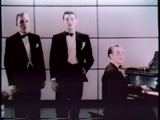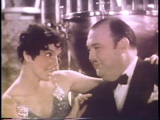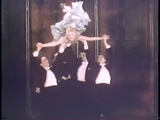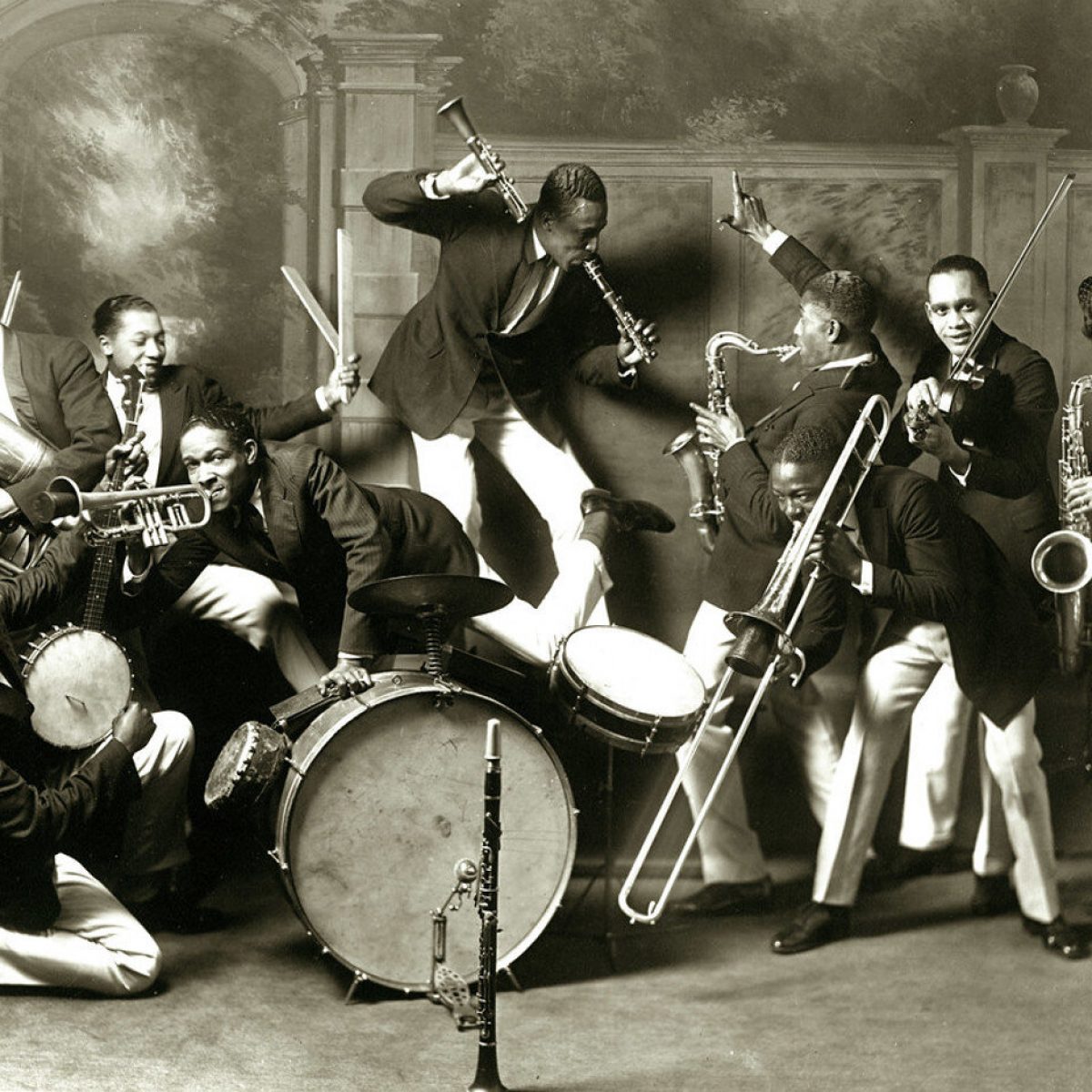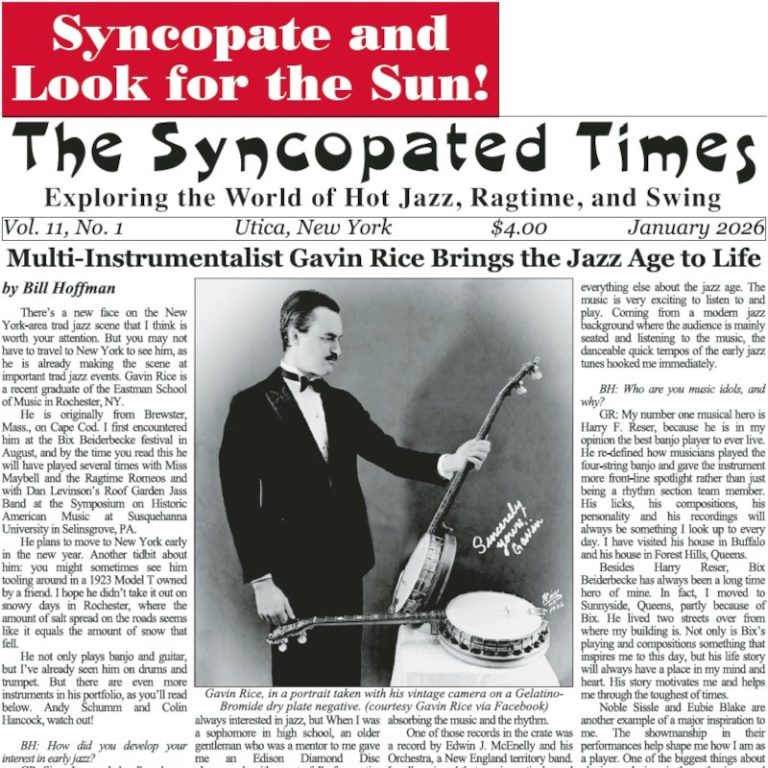|
This page by Dennis Pereyra: During the month of November in 1928, Schofield had traveled on the road with the Whiteman Orchestra, meeting with Whiteman to discuss the story on the train between stops. On December 23, 1928, Paul Whiteman gave a concert at Carnegie Hall, with Bee Palmer as an added attraction. This concert was for the benefit of the Northwoods Sanitarium in Saranac Lake, New York, where show business patients were treated for tuberculosis. Universal Pictures filmed the concert for possible use in the motion picture planned with Whiteman in the following year. The film, “King of Jazz”, was finally completed in 1930, but did not include any of the footage from the Carnegie Hall concert. |
||||||||||||||||||||||||||||||||||||||||||||||||||||
The Paul Whiteman Orchestra left New York on May 24th, 1929 on the Old Gold Special train (Old Gold cigarettes was the sponsor of the band’s CBS radio program, the Old Gold – Paul Whiteman Hour). The train had three sleepers, a dining car, a club car, two baggage cars, and an observation car, and was magnificent with its red, green and gold exterior.  Including the band’s entourage, there were fifty aboard the train. The planned route included stops in over a dozen important cities, for scheduled concerts, mini-programs at the train station and for the weekly Old Gold radio program. The band arrived in Los Angeles on June 15th, 1929, and reported to Universal Studios for the filming of the movie on June 28th, 1929. To make the band feel at home, Universal built a big lodge on the back lot. As time wore on, the musicians made other housing arrangements. During this time, Paul pressed his courtship with actress Margaret Livingston, whom he would later marry. While Whiteman waited for the completion of an agreed-upon film script, the band continued the weekly Old Gold radio programs and played at parties of celebrities including Buster Keaton, Marion Davies, Charlie Chaplin, Douglas Fairbanks and Mary Pickford. The band left Los Angeles on August 27th, 1929 for New York until a script was ready and filming would begin. Including the band’s entourage, there were fifty aboard the train. The planned route included stops in over a dozen important cities, for scheduled concerts, mini-programs at the train station and for the weekly Old Gold radio program. The band arrived in Los Angeles on June 15th, 1929, and reported to Universal Studios for the filming of the movie on June 28th, 1929. To make the band feel at home, Universal built a big lodge on the back lot. As time wore on, the musicians made other housing arrangements. During this time, Paul pressed his courtship with actress Margaret Livingston, whom he would later marry. While Whiteman waited for the completion of an agreed-upon film script, the band continued the weekly Old Gold radio programs and played at parties of celebrities including Buster Keaton, Marion Davies, Charlie Chaplin, Douglas Fairbanks and Mary Pickford. The band left Los Angeles on August 27th, 1929 for New York until a script was ready and filming would begin.
Among the rejected script ideas for the film:
Finally, it was agreed that the film would be a revue, along the lines of a vaudeville or stage production. A procedure unique in motion picture technique was followed. The script was written, not before, but after the shooting of each sequence. Whiteman made arrangements with a local Ford dealer in Hollywood for each musician to pick out a new car, not-to-exceed $900. A total of 24 cars were purchased. Each car had a canvas cover on the spare tire emblazoned with Whiteman’s caricature head. When the Whiteman band went back to New York in August of 1929, the cars were put in storage. When the band returned in October of 1929, the cars were moved out of storage and used by the musicians. As time went on, more and more musicians discarded the spare tire cover to avoid easy identification. Whiteman had a roadster for his personal use that was brought to California on the Old Gold Special that carried the band across the country. After the script was completed the Paul Whiteman Orchestra left New York on October 22nd, 1929 by train, arrived in Los Angeles on October 25th, 1929 to shoot the film. Filming began shortly after this. Unlike the first trip and its delays, Paul and the band rarely had a day off once filming began. In November 1929, just after filming began, Bing Crosby was involved in a collision with another automobile, in which his passenger flew out of the car and was injured. A policeman smelled Bing’s breath and booked both drivers for reckless and drunken driving. Bing arrived in court wearing golfing clothes and expecting to pay a fine. However, a strict Prohibition judge sentenced him to 60 days in jail. Bing was transferred to a jail near the studio, and an arrangement was made for Bing to be escorted to and from the studio for filming by a policeman. Bing served about 40 days of his sentence before he was released. However, he lost the lead role in the “Song of the Dawn” production number to John Boles (Bing did the lead vocal on the studio recording of the song). However, Bing did appear with the Rhythm Boys singing “So the Bluebirds and the Blackbirds Got Together”, “A Bench in the Park” and “Happy Feet”, as well as singing for the opening credits and the cartoon. The musicians on the first trip in late May 1929 included Bix Beiderbecke, the legendary jazz cornetist. From June to late August 1929, the orchestra hung around giving concerts and radio broadcasts (Old Gold/Paul Whiteman Hour) while waiting for an agreement with the studio on an acceptable film script. Negotiations failed, and the orchestra returned to New York in August 1929. On September 13, Bix became ill during a recording session. Two days after this, Paul sent Bix home to Davenport to recover. When the orchestra returned to Hollywood in October of 1929 to film the movie King of Jazz, Bix did not make the trip due to illness, so we do not have a filmed record of Bix playing the cornet in a featured solo in the movie. The time from the initial planned start of filming on January 15, 1929 to arrival of Paul Whiteman and the Orchestra in Hollywood to film the movie in late June 1929 to the completion of the filming of the movie in early February 1930 is about 11 1/2 months. The initial planned date of filming was delayed until June 1929 since no script was available. The band arrived in late June 1929 to start filming, left in late August 1929 because of a lack of a film script and returned in late October 1929 to start filming. Actual filming took about 3 months of the 11 1/2 months, from November 1929 to early February 1930, with retakes done during two weeks in March 1930. The Los Angeles premiere of the film was held on April 20th, 1930 at the Criterion Theater. Receipts from the film were below expectations within the first 2 weeks. The grand premiere of the film was held on May 2nd, 1930 at the Roxy Theater in New York. At the Roxy Theater premiere, the Whiteman Orchestra, together with George Gershwin and the 125-piece Roxy Symphony Orchestra, put on a stage show. This show featured the Rhapsody in Blue and Mildred Bailey backed by the Roxy Chorus. This stage show was performed five times a day, between showings of the movie. The stage show ran for only one week, and the movie showings continued at thr Roxy for only one additional week. Carl Laemmle made at least 9 different foreign versions of the film, each with a different master of ceremonies (MC), including:
The movie was originally 105 minutes long, but was shortened to 93 minutes after the following production numbers were cut from the film:
“King of Jazz” was the second all-talking motion picture filmed entirely in 2-color technicolor (not just color sequences). The first one was the 1929 Warner Brothers motion picture “On With The Show”. At the time, Technicolor was a 2-color process incoporating red and green, with no blue. Lamps with colored projection were used, mainly side lighting through red and green gelatin spots on a white background. For the missing blue color (as in Rhapsody in BLUE), the set director Herman Rosse and director John Murray Anderson came up with an ingeneous solution. Tests were made of various fabrics and pigments, and by using an all gray-and-silver background, arrived at a shade of green which gave the illusion of peacock blue. Also, filters were used to simulate the blue color, resulting in pastel shades rather than bright colors.
“King of Jazz” was the first motion picture to use a pre-recorded soundtrack made independently of the actual filming. Whiteman insisted that the entire soundtrack should be pre-recorded in order to obtain the best sound, and avoiding the poor recording conditions and extraneous noises found in a movie studio. Universal opposed the idea, but Whiteman insisted and prevailed over the reluctant studio executives. After the sound was recorded, the scene was filmed. Later, the film was synchronized to the soundtrack. Also, this allowed the movie to be directed in the same manner as a silent film, with resulting sounds not affecting the completed film. The movie won an Oscar for Herman Rosse in the category of Best Art Decoration/Set Decoration in 1930 (the only category for which the film was nominated). The Oscar was presented at the Academy Awards ceremony held on November 5, 1930 at 8:00 PM in the Fiesta Room of the Ambassador Hotel in Los Angeles, California. This ceremony was broadcast on the radio. The initial budget for the film was $1.5 million dollars. Because of the long delays in developing a script, weekly salaries and living quarters of Whiteman and the band musicians while they waited, expensive sets built and torn down unused, and the lavish expense on the film, about half a million dollars had been spent before the cameras ever rolled! The final cost of the movie was nearly $2 million in 1930. Based on inflation, the cost of the movie would translate into about $21 million in today’s dollars. During its national release, “King of Jazz” cleared less than $900,000. Around Hollywood, the movie came to be called “Universal’s Rhapsody in the Red”. Overseas, it fared better and eventually made a profit. During the 1930s, the film found its best audience in Cape Town, South Africa, where it played seventeen return engagements. Unfortunately, the delays in obtaining a script resulted in two factors that affected the profitability of the film. First, the public was tiring of the plethora of movie musicals that started with the film “Broadway Melody” in 1929. Also, the Depression resulted in an economic downturn that caused people to focus more on essentials, thereby preventing a more successful run of the movie. In fact, because of poor box office receipts and the Old Gold radio program not being renewed in April 1930, Whiteman had to let 10 bandmembers go and cut salaries by 15% on the remaining bandmembers. To find out more information about the movie, please go to the Internet Movie Database (IMDb) website for the movie. The Internet Archive has a copy of the film’s trailer. Since the above was written the King of Jazz has been lovingly restored, please read: 1930 King of Jazz Film Restored and King of Jazz: Paul Whiteman’s Technicolor Review
|
||||||||||||||||||||||||||||||||||||||||||||||||||||
|
Redhotjazz.com was a pioneering website during the "Information wants to be Free" era of the 1990s. In that spirit we are recovering the lost data from the now defunct site and sharing it with you.
Most of the music in the archive is in the form of MP3s hosted on Archive.org or the French servers of Jazz-on-line.com where this music is all in the public domain.
Files unavailable from those sources we host ourselves. They were made from original 78 RPM records in the hands of private collectors in the 1990s who contributed to the original redhotjazz.com. They were hosted as .ra files originally and we have converted them into the more modern MP3 format. They are of inferior quality to what is available commercially and are intended for reference purposes only. In some cases a Real Audio (.ra) file from Archive.org will download. Don't be scared! Those files will play in many music programs, but not Windows Media Player.


 On October 23, 1928, a deal was made with Carl Laemmle and Nat Goldstone of Universal Studios for
On October 23, 1928, a deal was made with Carl Laemmle and Nat Goldstone of Universal Studios for 
 The movie included the first Technicolor animated cartoon segment by animators Walter Lantz (later famous for Woody Woodpecker and other characters) and William Nolan. In this cartoon, Whiteman is hunting in darkest Africa when he is chased by a lion, who is soothed with the music from his violin (“Music Hath Charms”, with
The movie included the first Technicolor animated cartoon segment by animators Walter Lantz (later famous for Woody Woodpecker and other characters) and William Nolan. In this cartoon, Whiteman is hunting in darkest Africa when he is chased by a lion, who is soothed with the music from his violin (“Music Hath Charms”, with  Lantz. Additionally a black-and-white sound cartoon featuring Oswald the Lucky Rabbit titled
Lantz. Additionally a black-and-white sound cartoon featuring Oswald the Lucky Rabbit titled 







